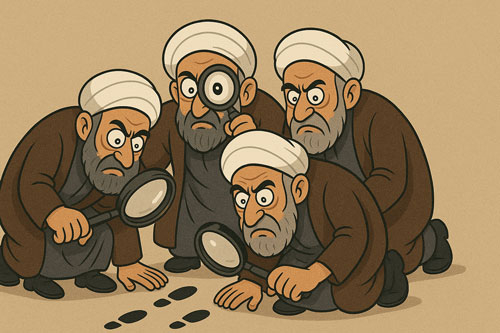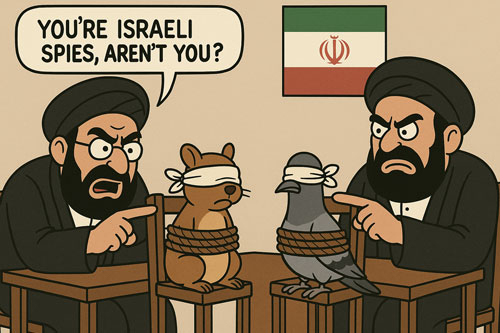 Image generated by AI |
Israeli intelligence officers have been smuggling weapons, drones, communication gear, and even vehicles into Iran for years using "suitcases, trucks and tankers." They and their Iranian agents have been spreading equipment throughout the Islamic Republic.
And what have Iran's "crazy state" counterespionage professionals been doing?
In 2007, the Islamic Republic News Agency (IRNA) reported that "in recent weeks intelligence operatives have arrested 14 squirrels within Iran's borders ... The squirrels were carrying spy gear of foreign agencies, and were stopped before they could act, thanks to the alertness of our intelligence agencies." While the "alert" intelligence agents were preoccupied with spy squirrels, real spies were busy downloading the Stuxnet supervirus into Iran's enrichment facilities, causing their centrifuges to spin out of control.
In October 2008, Iranian authorities detained two pigeons caught "spying" near the Natanz nuclear facility. Oddly enough, it was not the first case of suspected avian eavesdropping around Natanz. The Etemad Melli newspaper quoted Commander Esmaeil Ahmadi-Moqadam who confirmed the arrests and added that weeks earlier, "a black pigeon was caught bearing a blue-coated metal ring with invisible strings." As Iranian authorities investigated birds, nearby, undetected Mossad agents photographed the reactor site, mapped entrances and ventilation shafts, and took GPS coordinates.
 Image generated by AI |
During the drought of 2017-18, Brigadier General Gholam Reza Jalali accused Israel of "working to ensure clouds entering Iranian skies are unable to release rain." Jalali, then the head of Iran's Civil Defense Organization, claimed that "Joint teams from Israel and one of the neighboring countries make the clouds entering Iran barren. Moreover, we are faced with the cases of cloud theft and snow theft." While Iranian generals looked to the clouds, down on earth, Israeli spies catalogued the regime's "safe houses."
In February 2018, Hassan Firuzabadi, a senior military advisor to Khamenei, boasted about Iran's success in detecting Western spies with an anecdote about a group of people who had infiltrated Iran with "a variety of reptile desert species like lizards, chameleons ... We found out that their skin attracts atomic waves and that they were nuclear spies who wanted to find out where inside the Islamic Republic of Iran we have uranium mines and where we are engaged in atomic activities."
General Firuzabadi, the former chief of staff of Iran's armed forces, couldn't resist a taking a parting shot, boisterously claiming that Western spy agencies "failed every time."
Of course, the real spies knew exactly where "atomic activities" were carried being out.
Prior to October 7, Israel had accomplished some remarkable feats of spy craft inside Iran. In addition to the Stuxnet caper, Israel killed Mohsen Fakhrizadeh, the director of Iran's nuclear program, on November 27, 2020. He wasn't the first Iranian nuclear scientist to be eliminated, but Israeli spies accomplished the task with sci-fi panache using a remote-control gun just a few miles east of Tehran.
After October 7, Israel began eliminating its enemies throughout the Iranian terror empire, including Lebanon where on July 30, 2024, it killed Fuad Shukr, the Hezbollah co-founder who masterminded the 1983 bombing of the U.S. Marine barracks in Beirut.
The very next day, July 31, Israel foreshadowed what would come in the Twelve-Day War by killing Hamas leader Ismail Haniyeh in Tehran. Its patient spies had smuggled a small bomb into the VIP guest house months prior to the assassination. The hit further degraded an already diminished Hamas, and its precision and timing embarrassed Iran's leaders.
But it was not until the Twelve-Day War that Israel demonstrated the extent to which its spies have been studying their targets, learning their habits and routines. While Iran's counter-espionage professionals interrogated and likely executed squirrels, pigeons, and lizards, the real spies had been laboring for decades and their efforts paid off with spectacular results.
On the first day of the Twelve-Day War, June 13, 2025, Israel knew the exact whereabouts of Hossein Salami, Commander of the IRGC, Mohammad Bagheri, Armed Forces Chief, Brigadier General Gholamali Rashid, and Amir Ali Hajizadeh, Commander of the IRGC Aerospace Force. None lived to see the second day of the war.
Also on the first day of the war, Iran's top nuclear scientists were hoodwinked into attending meetings and then killed simultaneously. One of them was Fereydoon Abbasi-Devani who, according to a Wall Street Journal report, recently claimed he had everything necessary to build a nuclear bomb. "If they tell me to build a bomb, I will build it," he said.
On the final day of the war, Israel killed Sayyed Mohammad Reza Seddighi Saber, the head of the SPND, the agency in charge of nuclear explosion research. The U.S. State Department had only recently come to understand Saber's importance, having sanctioned him in May. Israeli spies knew where he lived.
A ceasefire ended the Twelve-Day War, but psychological operations continued. The normally secretive Mossad even released videos of its commandos assembling counter missile weapons inside Iran.
Though many top regime figures and nuclear scientists did not survive the brief war, those who did live in fear knowing that Israeli spies are watching them.
The biggest remaining target, of course, is Ali Khamenei – the "Hidden Imam" who has not been seen in public since June 11.
Right now, his bodyguards are probably frisking rats and questioning cockroaches in whatever squalid underground bunker he currently calls home.
 Chief IPT Political Correspondent A.J. Caschetta is a principal lecturer at the Rochester Institute of Technology and a fellow at Campus Watch, a project of the Middle East Forum where he is also a Milstein fellow.
Chief IPT Political Correspondent A.J. Caschetta is a principal lecturer at the Rochester Institute of Technology and a fellow at Campus Watch, a project of the Middle East Forum where he is also a Milstein fellow.
Copyright © 2025. Investigative Project on Terrorism. All rights reserved.
